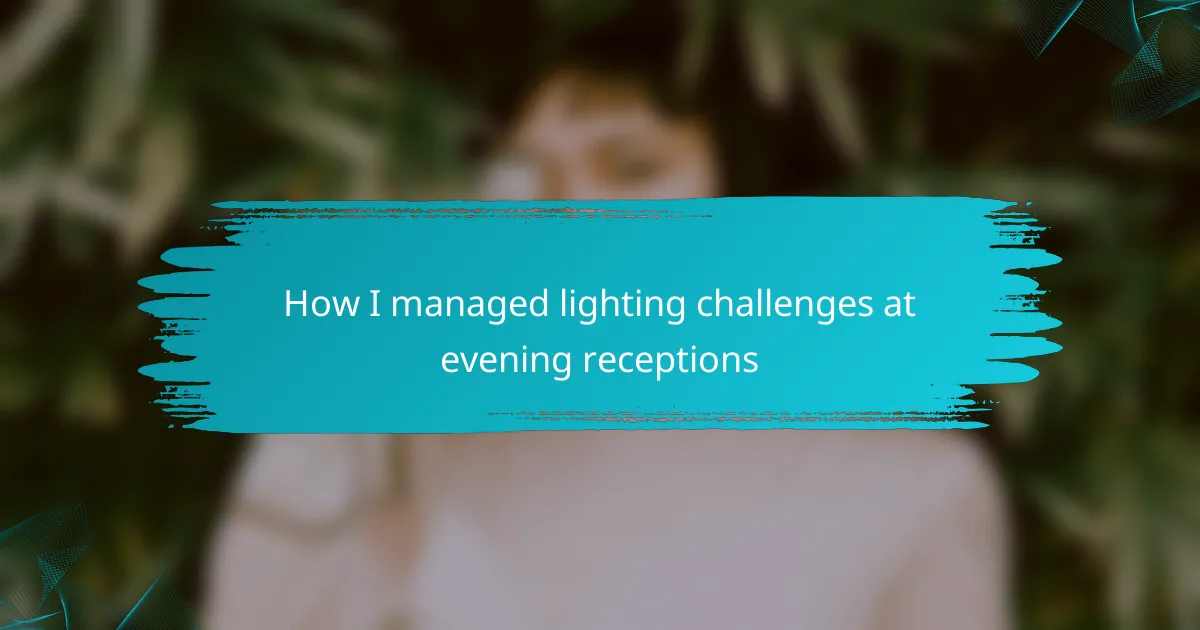Key takeaways
- Proper understanding of lighting—both natural and artificial—is essential for capturing beautiful wedding photos, especially in low light conditions.
- Utilizing equipment like fast lenses, external flashes, and reflectors can significantly enhance photography quality during evening receptions.
- Preparation and adaptability are crucial when facing lighting challenges; familiarizing oneself with the venue ahead of time can lead to better shot planning.
- Experimenting with ambient light, exposure settings, and creative solutions helps create stunning and memorable photographs in challenging lighting scenarios.
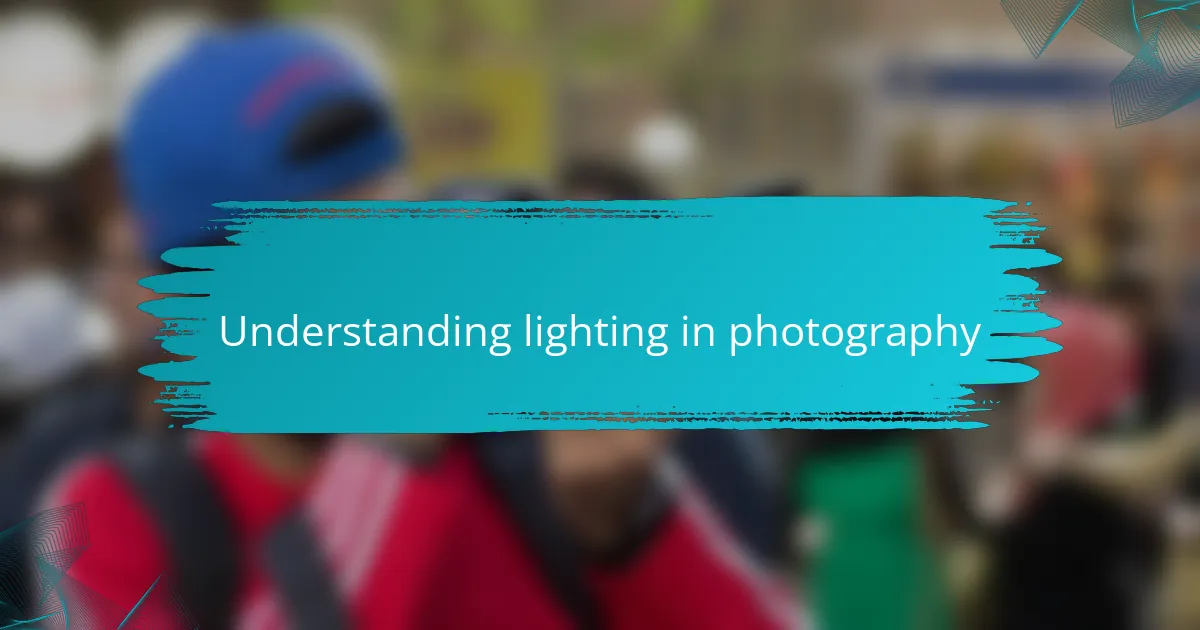
Understanding lighting in photography
Lighting plays a crucial role in photography, shaping not just the image but the mood and atmosphere of the moment captured. I remember my early days as a wedding photographer, walking into the reception room and feeling a mix of excitement and trepidation as I faced the dim lighting. It made me realize how essential it is to understand the available light – natural or artificial – to create stunning images.
When the sun sets, indoor lighting often becomes less forgiving. Have you ever struggled with harsh overhead lights or dark corners? I have. It’s easy to feel overwhelmed, but I’ve learned that using my camera settings wisely can transform those challenges. Adjusting the ISO, aperture, and shutter speed can drastically change the outcome and help bring that evening romance to life.
With every wedding I shoot, I see unique lighting scenarios – from twinkling fairy lights to candles casting warm glows. Each setup offers a chance for creativity. I often ask myself, “How can I best use this light?” Exploring shadows and highlights has not only improved my photography but has also deepened my connection to the couples I work with, allowing their love stories to shine beautifully despite the constraints of evening illumination.
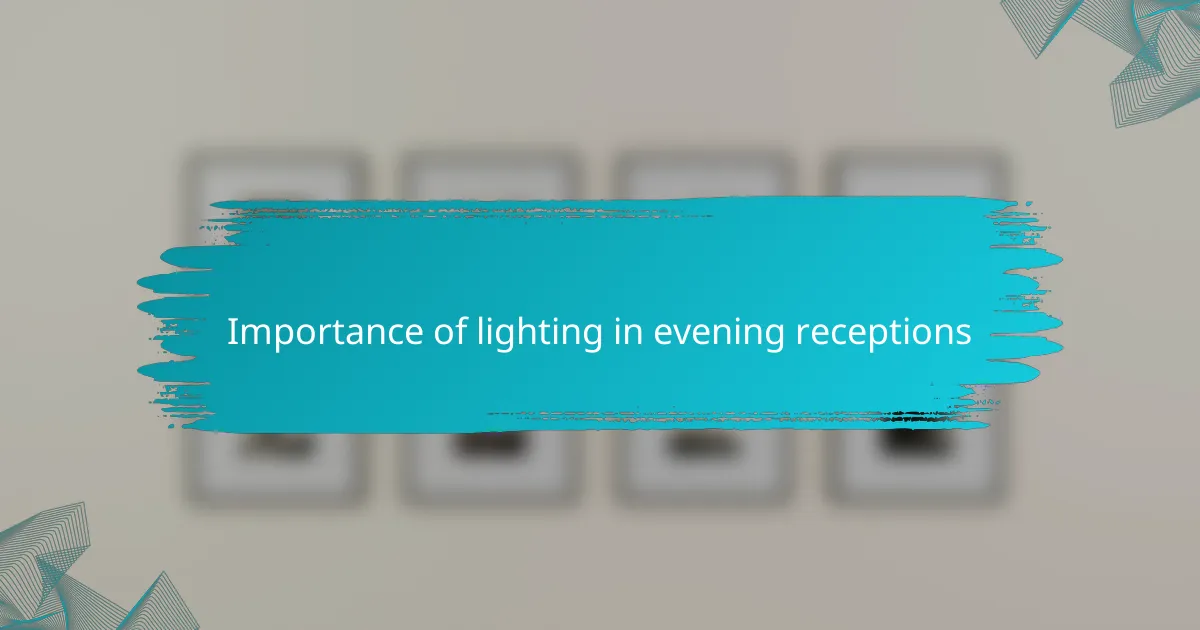
Importance of lighting in evening receptions
Lighting plays a crucial role in setting the mood for evening receptions. From my experience, the right lighting can transform a venue, creating a warm, romantic atmosphere while enhancing colors and details in photographs. I remember one wedding where the couple chose soft, ambient lighting; it not only made their outdoor setting magical but also made the images appear ethereal.
When I faced lighting challenges at a recent evening reception, I quickly learned that understanding the types of lighting available is essential. Here are some key considerations:
- Natural vs. Artificial Light: Know when the sun sets and how your photos can benefit from both types of lighting.
- Color Temperature: Different lights produce different shades, affecting the overall feel of your photos. Warm lights evoke coziness, while cooler lights can create a modern edge.
- Light Placement: Strategic positioning of lights can highlight important elements, like the couple’s table or floral arrangements.
- Using Reflectors: These can bounce light to fill in shadows, ensuring the couple looks their best.
- Experiment with Filters: Softening filters can create a dreamy effect, enhancing the romantic vibe of evening receptions.
Understanding these aspects will help you navigate the complexities of evening reception lighting and ultimately capture breathtaking images.
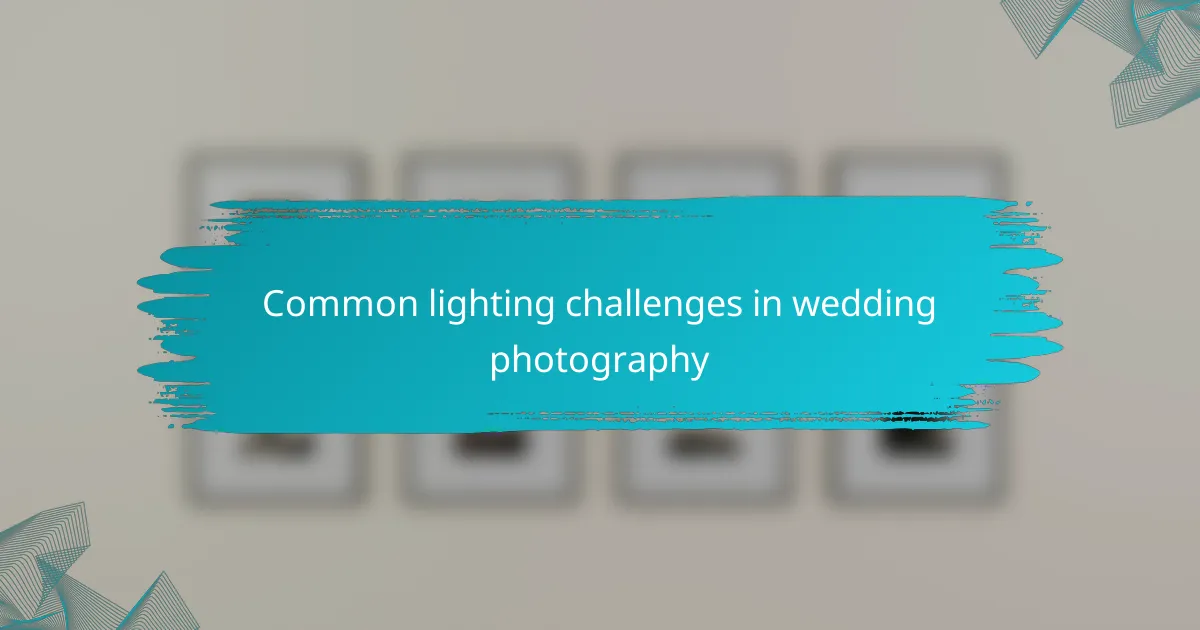
Common lighting challenges in wedding photography
Every wedding photographer faces distinct lighting challenges, especially during evening receptions. I recall one particular wedding where the venue relied heavily on ambient lighting, which created a moody and romantic atmosphere but left many of my shots underexposed. This experience taught me the importance of adapting quickly and using external flash or reflecting surfaces to capture those precious moments without losing the essence of the evening.
Here are some common lighting challenges I’ve encountered during evening receptions:
- Low Light Conditions: Many venues lack sufficient lighting, making it tough to get sharp, well-exposed photos.
- Mixed Light Sources: You might encounter a blend of warm and cool lighting tones, affecting skin tones and overall color balance.
- Backlighting: Photos taken against windows or bright backgrounds can lead to subjects appearing silhouetted if not managed properly.
- Distracting Shadows: Harsh shadows from candles or spotlights can create unflattering results if not carefully controlled.
- Flash Restrictions: Some venues have strict rules about using flash, posing a unique challenge to capturing the perfect shot.
These experiences have pushed me to think creatively and find innovative solutions, ensuring I still deliver beautiful photographs despite the challenges.
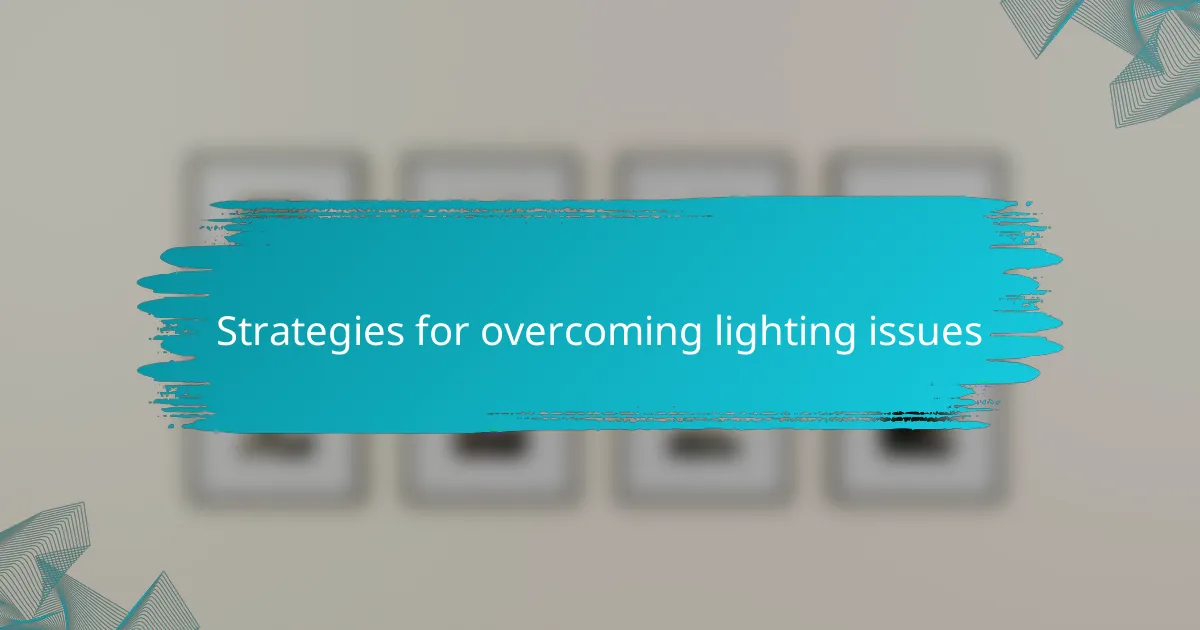
Strategies for overcoming lighting issues
When tackling lighting issues at evening receptions, one of my go-to strategies is to familiarize myself with the venue beforehand. Have you ever walked into a space and felt instantly inspired, or the opposite, completely thrown off? I remember one wedding where I had scouted the location earlier. I discovered the best spots to use the ambient light, allowing me to plan my shots around the cascading glow of chandelier fixtures and table candles. This preparation gives me confidence and clarity, especially when the sun dips below the horizon.
Another method I find invaluable is utilizing a fast lens. This is a personal favorite of mine. When I pull out my f/1.8 or f/2.8 lens, I sometimes feel like I’m wielding a magic wand. It allows me to capture sharper images in low light without cranking up the ISO too high, which can introduce unwanted noise. Have you noticed how a shallow depth of field can beautifully separate the subject from the background? Trust me, it can transform an otherwise ordinary shot into something extraordinary, making the couple’s joy radiate even in dim lighting.
Lastly, I often carry a small portable softbox or diffuser. These little tools have saved me on countless occasions. They soften the harshness of built-in flashes or even artificial venue lights. I recall a wedding where the dance floor lights were particularly harsh, casting unflattering shadows on the couple. Using my softbox, I created a soft, flattering light that turned those moments into cherished memories rather than harsh images. It’s surprising how such a simple solution can elevate that emotional connection in a photograph.
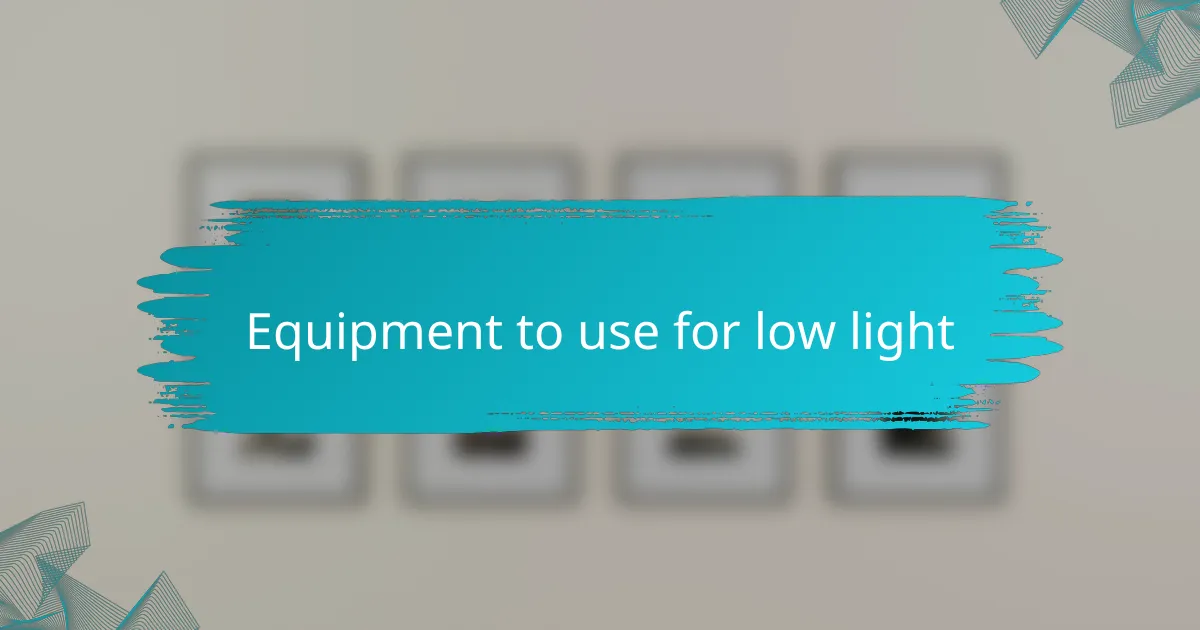
Equipment to use for low light
When it comes to capturing the magic of evening receptions, having the right equipment is essential. Personally, I’ve found that a fast lens with a wide aperture—like a 50mm f/1.8—is a game changer. It allows more light to hit the sensor, creating beautiful, soft background bokeh that enhances the subject, making your photos truly captivating.
Another crucial piece of gear is a reliable external flash. I always recommend a flash that can be tilted and swiveled. This versatility allows you to bounce the light off walls or ceilings, rather than just blasting it directly at your subjects. Trust me, this technique diffuses the light beautifully and reduces harsh shadows.
Here’s a quick comparison of the equipment that I frequently use for low light conditions:
| Equipment | Benefits |
|---|---|
| Fast Lens (e.g., 50mm f/1.8) | Great low-light performance, beautiful bokeh. |
| External Flash | Versatile lighting options, reduces shadows when bounced. |
| Tripod | Stabilizes camera for longer exposures, sharp images. |
| Low-light Camera | Handles high ISO well, minimizes noise in dark settings. |
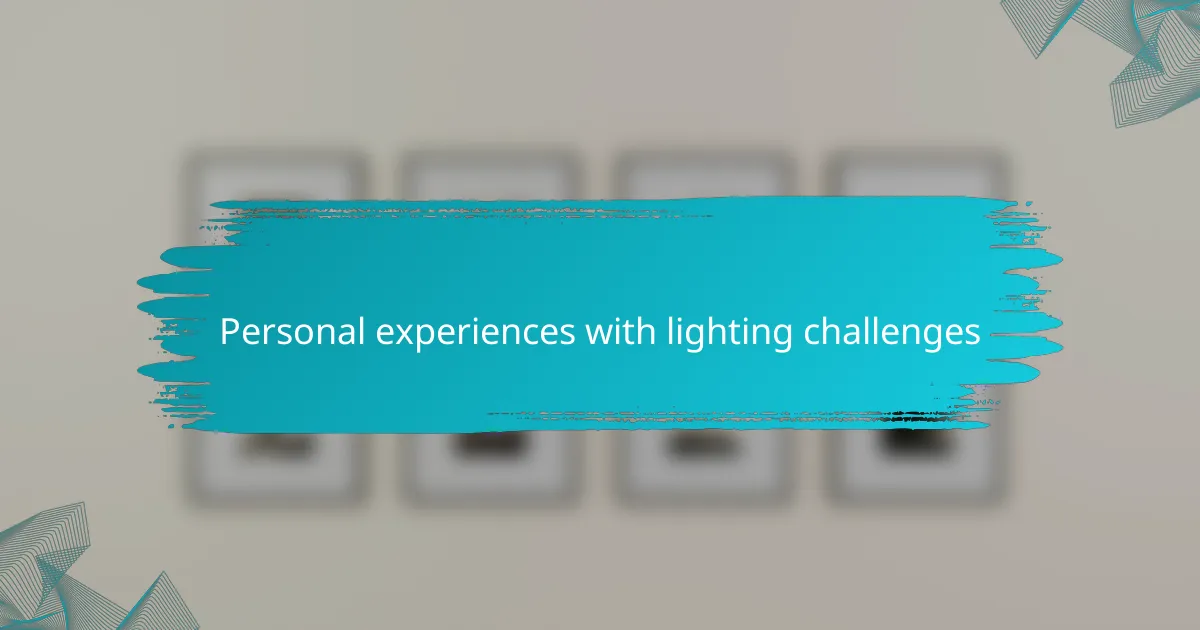
Personal experiences with lighting challenges
When I think back on the evening receptions I’ve photographed, lighting challenges usually come to mind first. There was a time at an outdoor wedding where the sun dipped below the horizon far quicker than expected, leaving me in near darkness. I remember juggling my camera settings, trying to capture the couple beneath the fairy lights while maintaining the magical ambiance they envisioned.
Another memorable evening was at an indoor reception where the venue’s low lighting created a beautiful, intimate atmosphere. However, that same atmosphere made it tough for my camera to find its footing. I had to rely on my creative instincts, adjusting my settings and using available light sources, which ended up adding a unique feel to the photographs.
It’s these experiences that taught me the importance of preparation and adaptability in low-light conditions. I learned that you can transform challenges into stunning, memorable shots if you stay calm and think outside the box.
| Challenge | Solution |
|---|---|
| Outdoor reception with rapid sunset | Adjust camera settings quickly; use flash creatively |
| Indoor low-light venue | Utilize available light sources; experiment with angles |
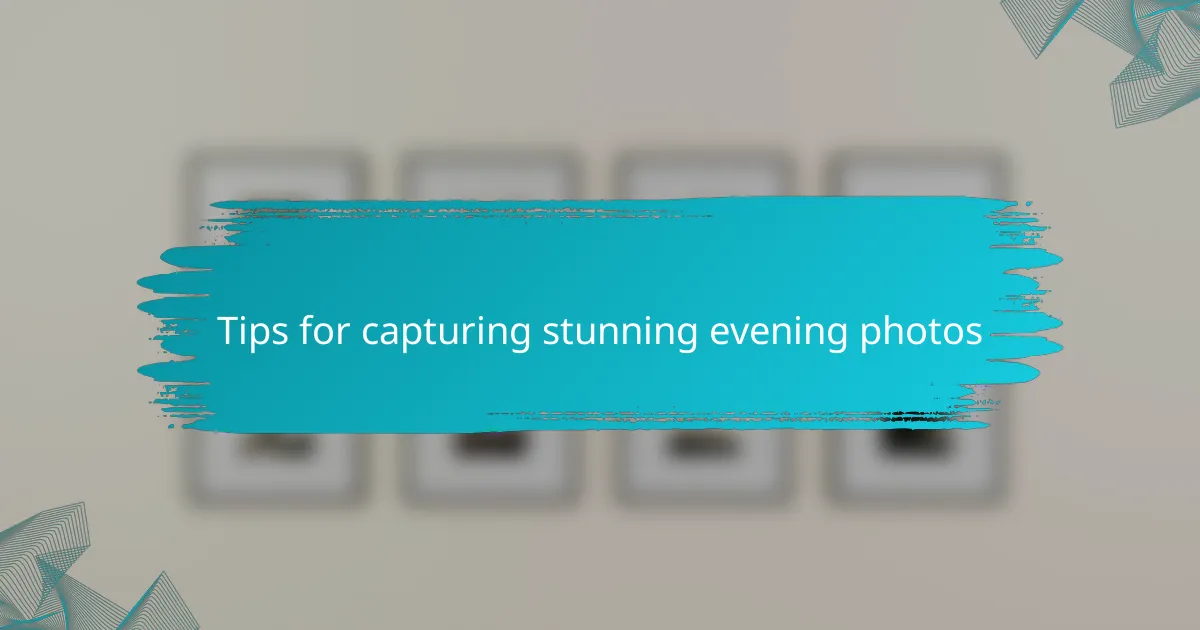
Tips for capturing stunning evening photos
When it comes to capturing stunning evening photos, playing with light is key. I often rely on available ambient light sources, like string lights and candles, to create a warm and inviting atmosphere. It’s amazing how this soft glow can enhance the intimacy of a couple’s special moment, making their joy even more palpable.
Utilizing a fast lens can significantly improve your evening photography. A lens that opens up to f/1.8 or lower allows more light, which can highlight the couple amidst the darkness beautifully. I remember one reception where I used my 50mm f/1.8 lens to catch candid moments of laughter and dancing; the results were magical.
Experimenting with exposure settings, such as adjusting the ISO, can also yield stunning results. I often keep my ISO higher to maintain detail without introducing too much noise. It’s all about striking that perfect balance to bring out the beauty of those twilight moments.
| Technique | Details |
|---|---|
| Natural Light Usage | Utilize ambient light from candles and string lights for a warm effect. |
| Fast Lens | A lens with a wide aperture (f/1.8 or lower) works well in low light. |
| Exposure Settings | Adjust ISO settings to enhance detail while managing noise. |
